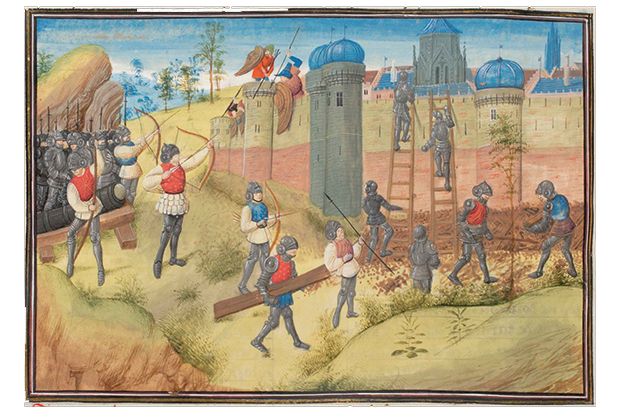The Detection Club is rather like the House of Lords of British crime writing, though considerably more select. (I should declare an interest: I’m a member of the club, so it’s possible I may be biased.)
Founded in 1930 by Agatha Christie and Dorothy L. Sayers among others, the club chooses new members by secret ballot. Candidates undergo an initiation ritual involving black candles, a billowing red robe originally designed for G.K. Chesterton, a terrifying sacred oath and a skull called Eric. (Forensic examination has demonstrated that Eric belonged to a female.)
The story of the club’s early years has been well told in The Golden Age of Murder by Martin Edwards, the current president. The so-called ‘rules’ of detective fiction, Ronald Knox’s ‘Decalogue’, were never taken seriously by members. Then as now, the Detection Club had two aims: to promote the crime writing genre in general and its members’ books in particular; and to hold regular dinners to mitigate the solitary agonies that characterise the life of every author. In order to further both aims, members occasionally publish anthologies of short stories or collaborative novels. The most popular of these joint ventures was The Floating Admiral, a perfectly formed whodunit complete with map, published in 1931 and reissued 80 years later.
Fifteen of today’s members have collaborated on a new novel, edited by Simon Brett, a past president of the club. In one sense, as its title suggests, it’s a homage to The Floating Admiral. To emphasise the point, the characters take their surnames from pre-war members of the club. Once again, it’s an exercise in literary consequences with corpses.
In his introduction, however, Brett makes the point that, unlike its predecessor, The Sinking Admiral isn’t a 1930s-style detective story, part crossword puzzle, part railway timetable. Crime fiction has changed and diversified since then, and the novel reflects that.
The story also draws on the expertise of individual contributors. Part of the fun for fans of the genre is trying to work out who wrote about the parish church and its vicar, and who wrote the chapters dealing with politics, high finance and so on. The authors agreed a narrative framework beforehand, though not the ending, with its all-important revelation of the murderer’s identity. Then they were let loose on their chapters.
The Admiral is Geoffrey Horatio Fitzsimmons, and ‘Admiral’ is his nickname, not his rank. He is — or, by the end of chapter three, was — the technophobic landlord of the Admiral Byng, a failing pub in Crabwell, which lies somewhere between Lowestoft and Southwold on the Suffolk coast. He is found drowned in his own waterlogged boat with a suicide note in his pocket. The note is automatically suspicious to everyone but the police since it is unsigned and written on a computer.
The police are an incompetent duo who get everything reliably wrong. The real investigators are a ruthlessly ambitious reality TV presenter and the pub’s manager, a supple redhead with a secret. (Just about everyone in this novel is nursing a secret.)
No one is free from suspicion. There’s the alcoholic editor of the local paper, the corrupt local solicitor and the vicar who is desperate to keep her crumbling church open. The local doctor is fiercely protective of her partner, a teacher trying to rescue a pupil from her teenage hormones. The voluptuous pub cook has a past and the local MP wants to forget his youthful wild oats. The hedge-fund manager in a puffa jacket has some very unexpected local connections. There’s also a drunken publisher with strong views on crime fiction (‘All crime fiction is bloody nonsense’).
Characters appear and reappear — and, as the authors change, so do the characters in terms of how they are perceived. The result is unexpectedly fascinating, providing subtly dissonant perspectives on the inhabitants of Crabwell. (Not unlike real life, perhaps.)
The result is a sort of anarchic Cluedo. The plot has a cheerfully makeshift quality. The ending turns on an insouciant coincidence the size of Mont Blanc. ‘I’ve seen so much coincidence happening in real life,’ says an elderly character, ‘that nothing surprises me any more.’
Does it work? Well, I found it enormously entertaining and technically fascinating. Mind you, I may be biased.
Growing Up
This morning, as I commuted through Hendon Central,
I remembered you telling me you saw
that day’s newspaper there on a board,
announcing the king had died, how life stalled
for a moment. This evening I got the call
I’d long dreaded, telling me you were dead.
‘We are not a grandchild,’ Thatcher might have said.
My kingdom has lost its last queen. I grow tall
into the footsteps of each late centenarian
grandmother, may start taking the Telegraph.
I cry, then hear both of them laugh
with an obstinacy that skipped a generation,
realise I’m now their only resurrection,
have crossed the chess board, no longer a pawn.— Sarah Wardle
The post Good clean fun appeared first on The Spectator.
Got something to add? Join the discussion and comment below.
Get 10 issues for just $10
Subscribe to The Spectator Australia today for the next 10 magazine issues, plus full online access, for just $10.
You might disagree with half of it, but you’ll enjoy reading all of it. Try your first month for free, then just $2 a week for the remainder of your first year.














Comments
Don't miss out
Join the conversation with other Spectator Australia readers. Subscribe to leave a comment.
SUBSCRIBEAlready a subscriber? Log in